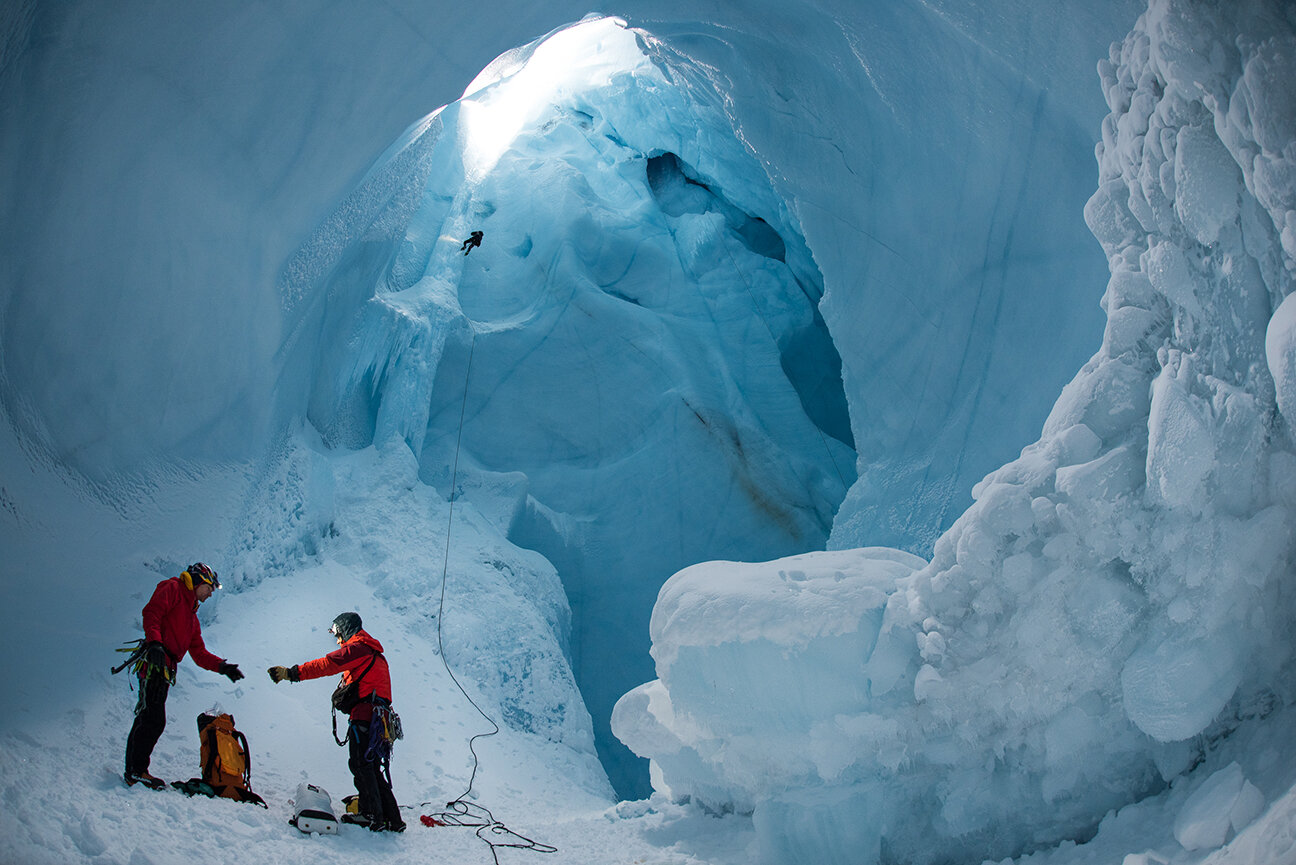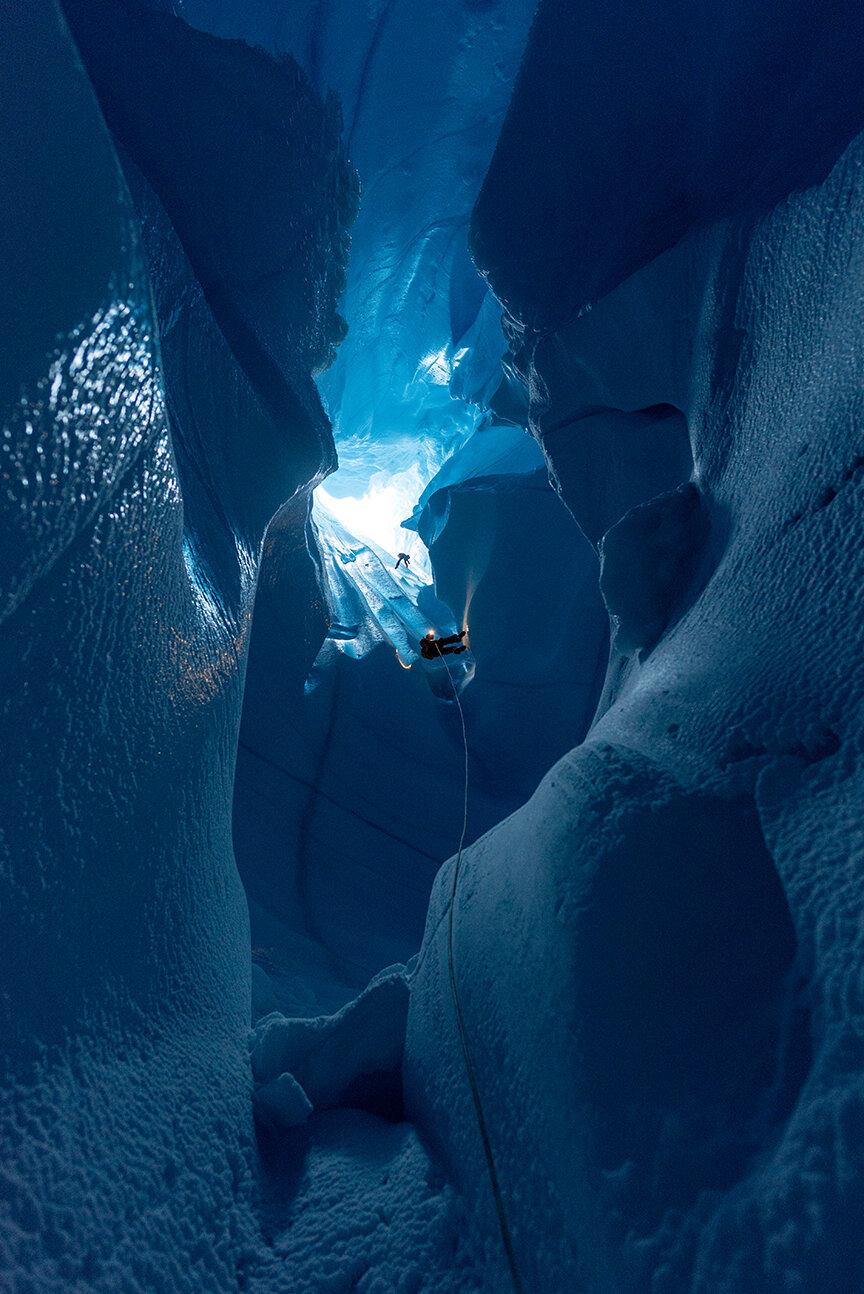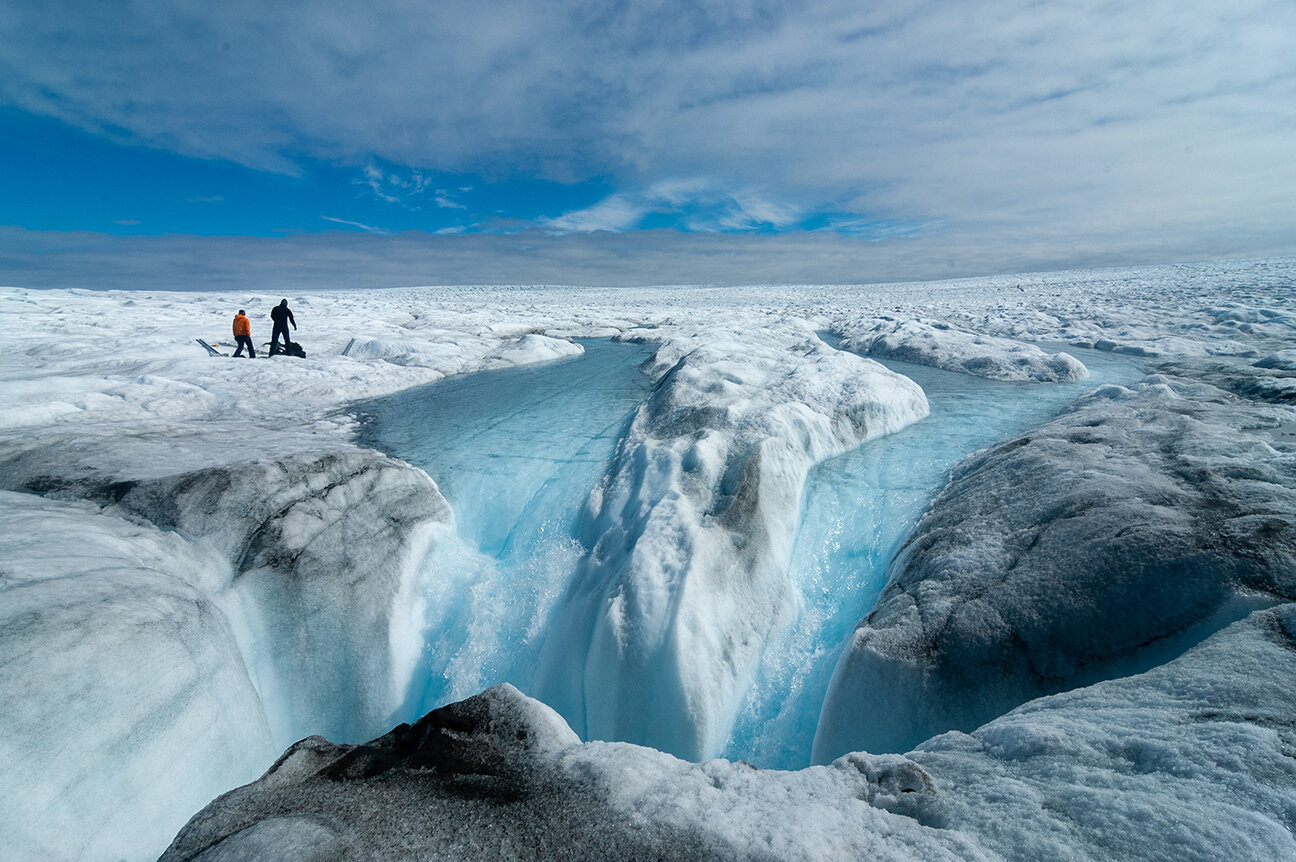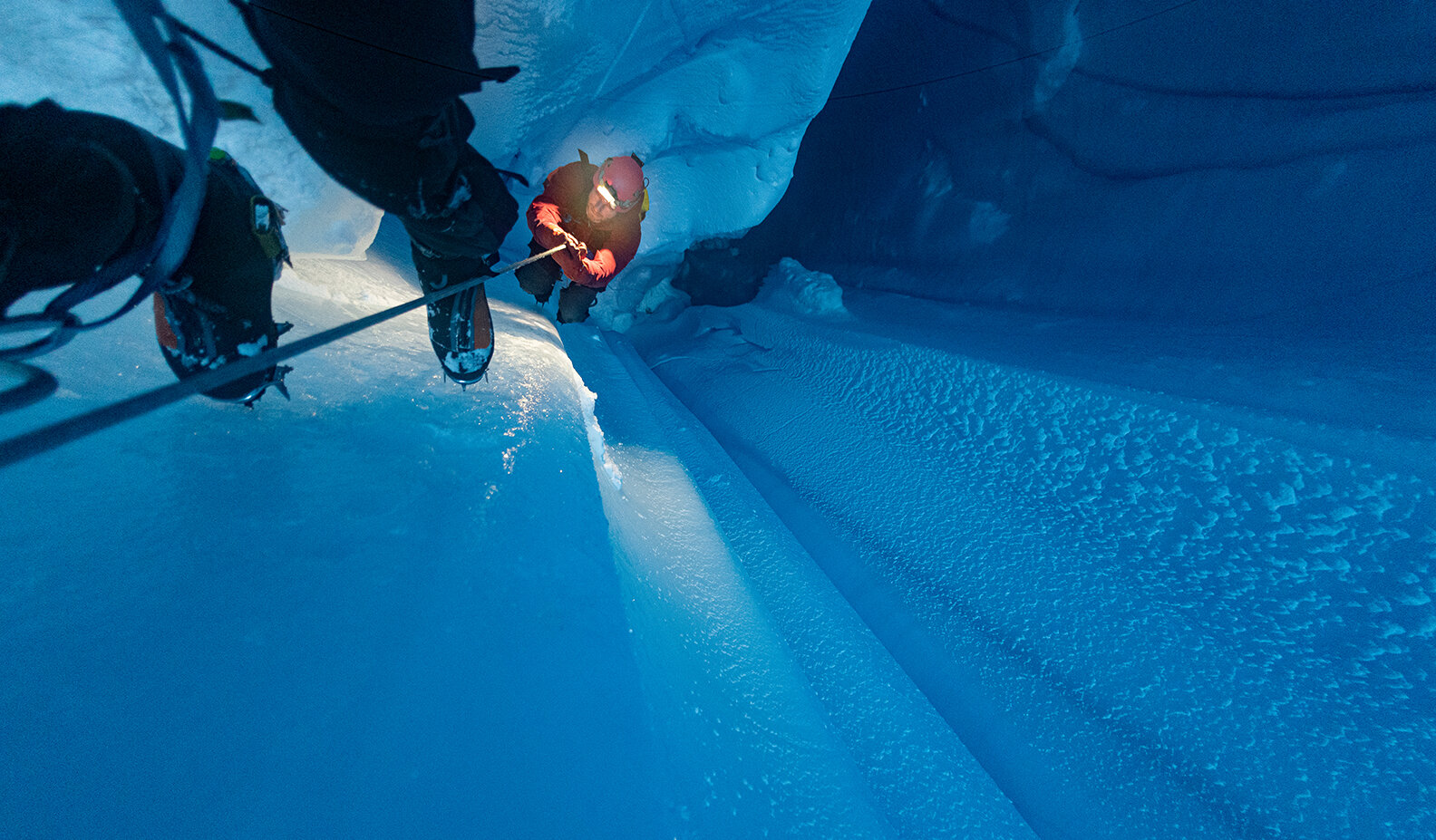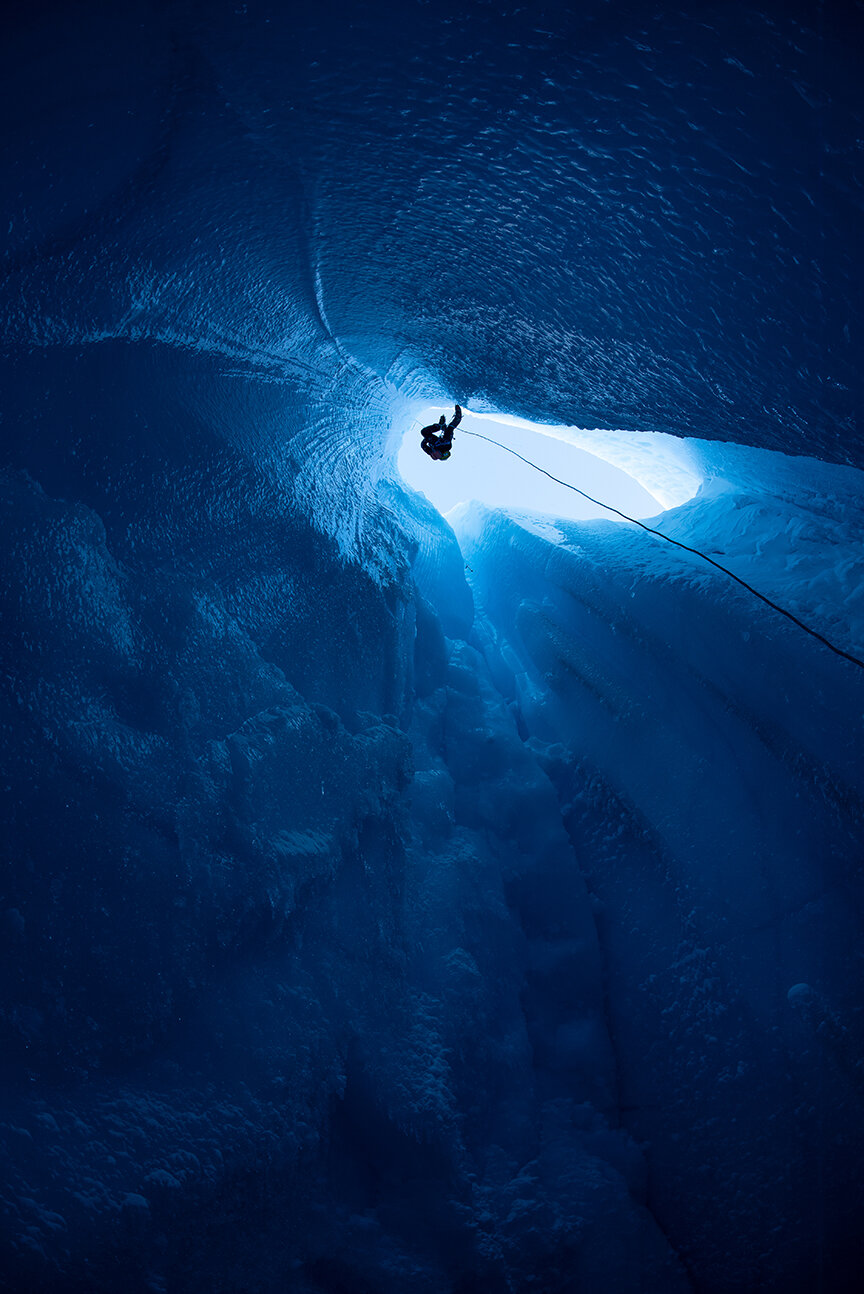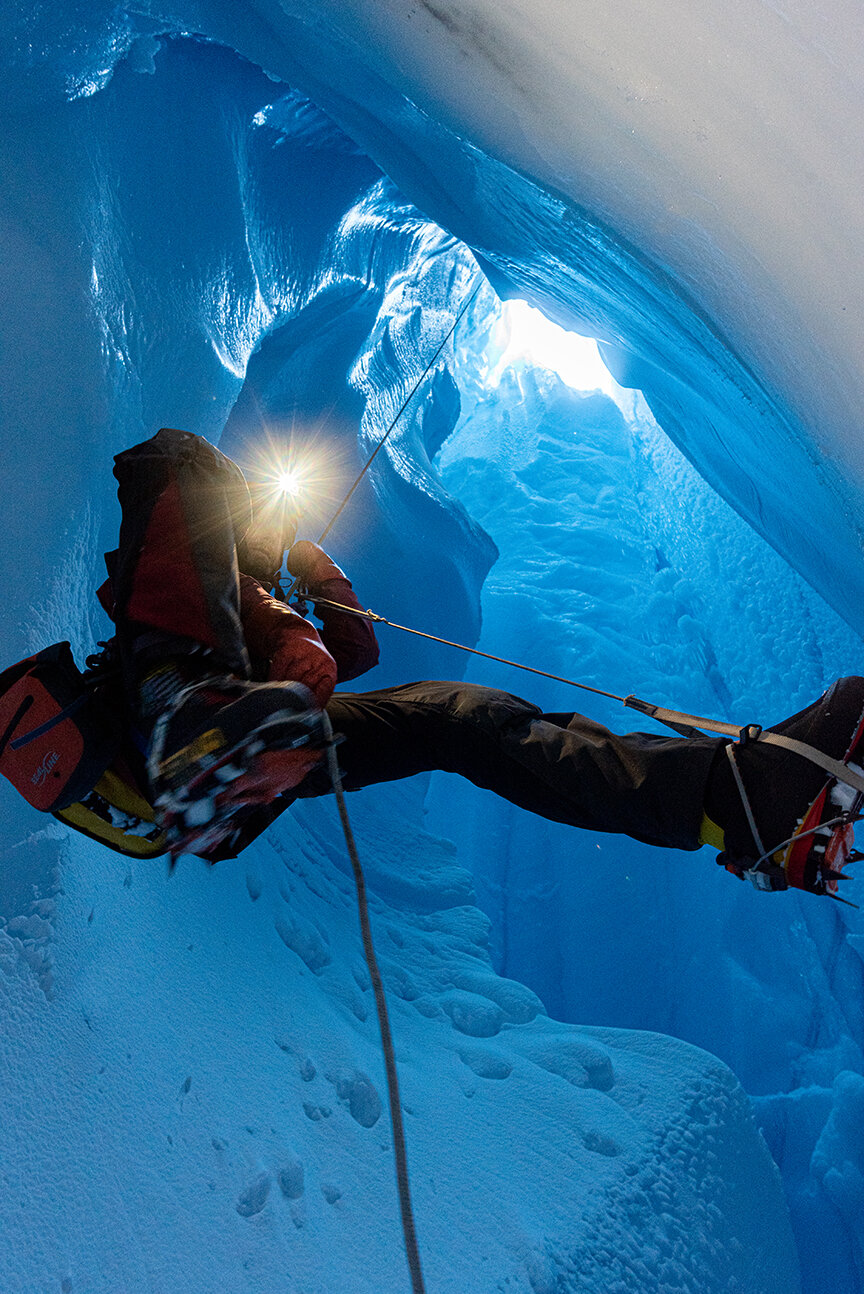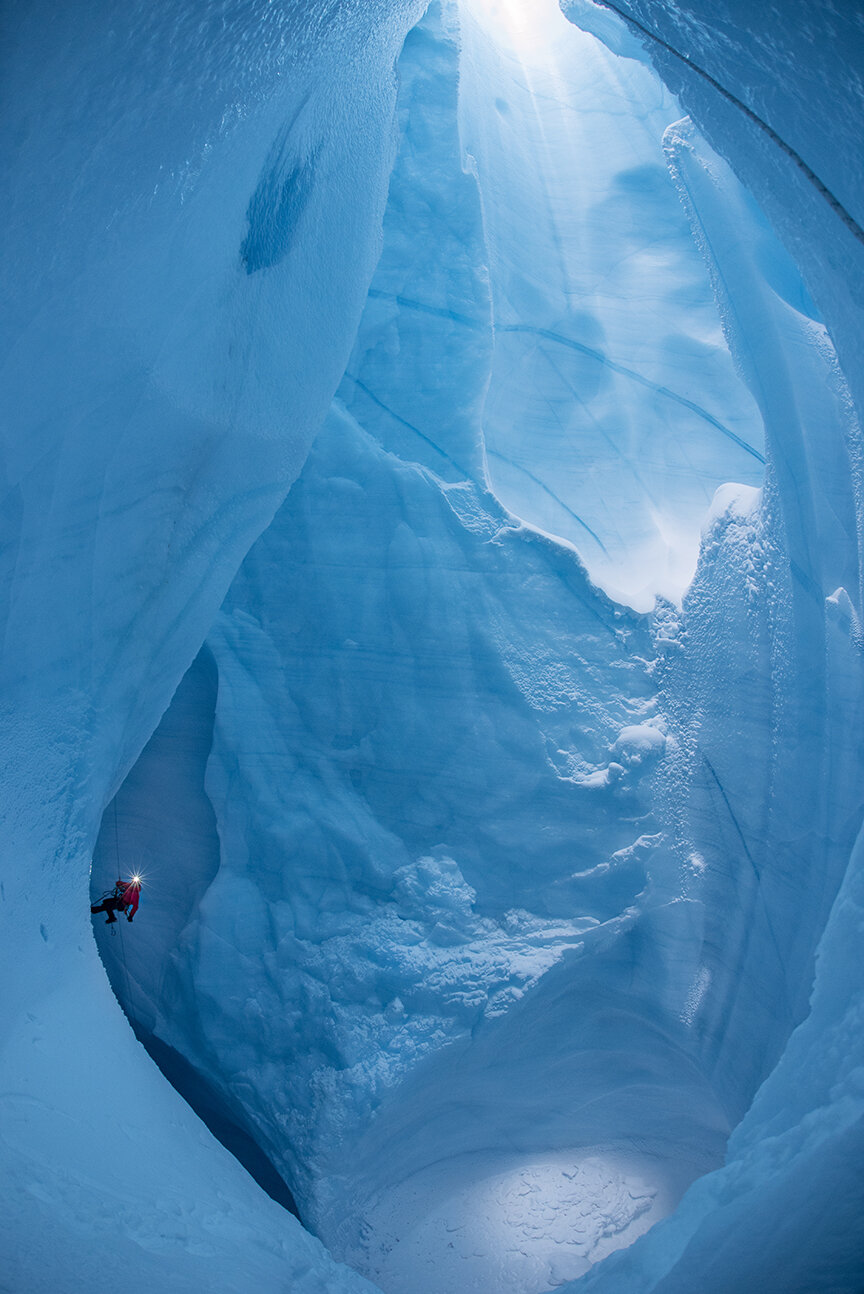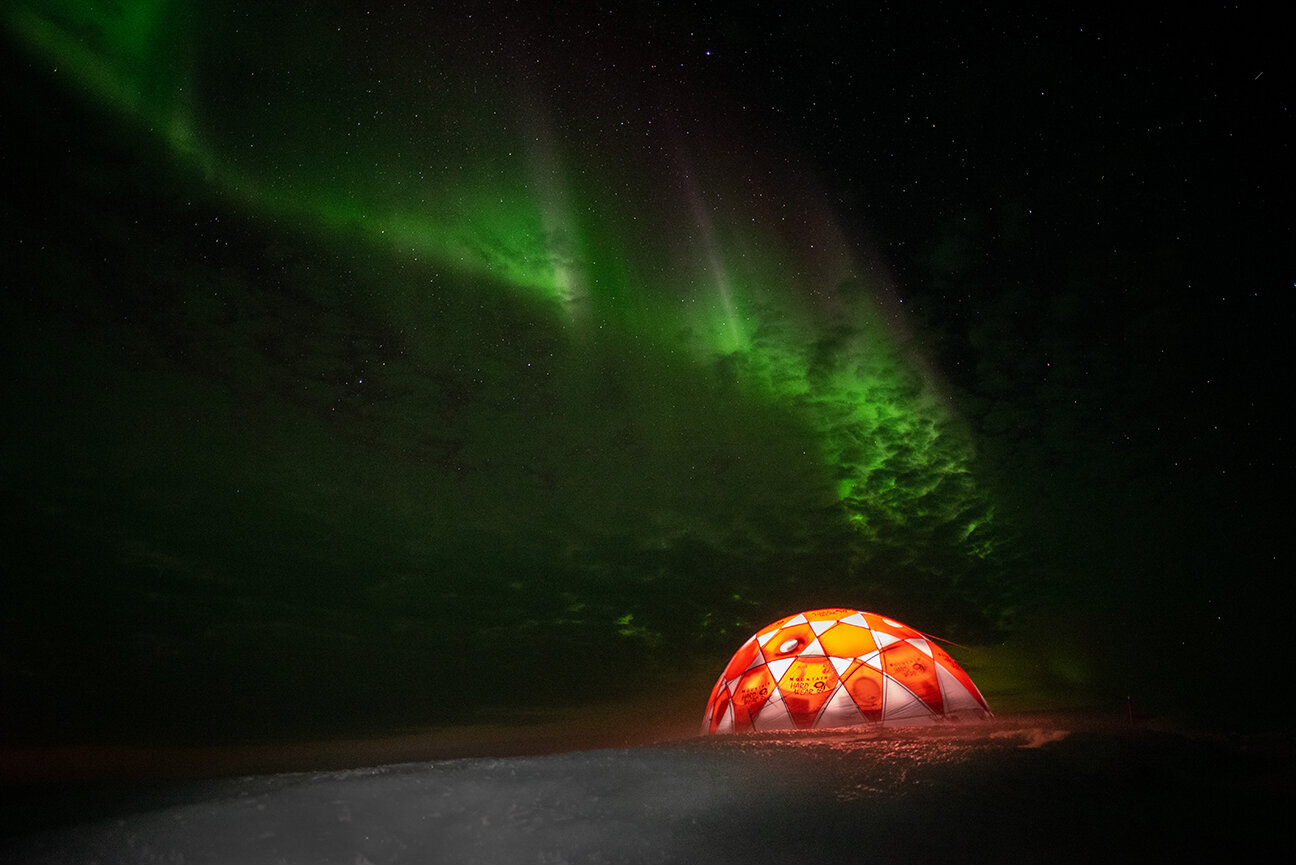Moulins Bleus
images by Jason Gulley
interview by Angela M.H. Schuster
With a surface area of 1.7 million square kilometers, the Greenland ice sheet is second in size only to that which cloaks Antarctica and covers some 79 percent of the largest island on Earth. If the ice sheet were to melt—and melting it is in the face of climate change—it would result in a worldwide sea-level rise of 6 meters. For the past two decades, glaciologists have been working to understand the mechanics of the melt, but their models had largely fallen short when it came to explaining the exponential rate at which it was happening. That was until recently, when a trio of intrepid explorers ventured into a suite of moulins, vast ephemeral ice caves previously thought too dangerous to investigate. The Explorers Journal caught up with glaciologists Matt Covington of the University of Arkansas and Jason Gulley of the University of South Florida, along with formidable ice climber Will Gadd, shortly after the October release of their ice-breaking paper, published by the American Geophysical Union. We talked about their daring work and its implications for understanding Greenland’s ice sheet dynamics. (Our in-depth conversation with them has been edited for length and clarity.)
The Explorers journal: What lured you into the magical world of ice caves?
Jason Gulley: It all began in 2004 over drinks with Doug Benn, a glaciologist from the University of St. Andrews in Scotland. He had been lecturing at the University of Cincinnati when a mutual friend brought him down to Kentucky to go rock climbing with us in the Red River Gorge. At the time, I was an undergraduate at Eastern Kentucky University with plans to pursue graduate work on karst caves.
Doug started talking about his work on Everest, in the Khumbu region, where he had been studying lakes that formed on glaciers, only to quickly drain through conduits that appeared in the ice. I was fascinated by his work, but then who doesn’t get excited about Everest? He showed me a couple of pictures and, from what I saw, the conduit shapes looked very much like limestone caves. My immediate reaction was, “Dude, has anybody been inside these things? If we can get inside these voids, we can probably figure out how they formed.” The next day, I took him to a limestone cave and showed him everything that we can infer about its formation based on bedding thickness, fracture frequency, and other telltale features. And I said, “If we can get into the Khumbu glacier caves, we can totally figure out how they formed.”
At the time, the only thing that Doug really knew about caves was that they were dark, and the only thing that I knew about glaciers was that they were cold. He had no background in caving, and I had no background in ice, but we got quite tight that night and wrote up bullet points for a series of expedition proposals.
We knew that the idea of going into glacier caves was so out-there that we were unlikely to get funding from major research organizations such the National Science Foundation (NSF) or the Natural Environment Research Council, the British equivalent, so we reached out to everyone we could think of. We ended up raising a little more than $10,000—some of which came from The Explorers Club. With my mom, who worked for an airline, able to get us standby tickets to Nepal for a reduced cost, we had just enough to fund our first expedition to Nepal—four people living in the Khumbu for two months—on the biggest shoestring budget ever.
What we found in the glacier caves was completely unexpected based on what was in the glaciological literature at the time. In preparation for our expedition, we assumed we would be encountering dendritic caves that were steeply dipping into the glacier, controlled by gradients in ice pressure, so we showed up in Nepal with two dozen ice screws and hundreds of meters of rope. Much to our surprise, every cave that we got into was horizontal. It was like, “Well, this is just not the way ice caves are supposed to be forming.” The other thing that we found was that they were all associated with debris bands in the ice. And it looked like there were heterogeneous features in the ice that were controlling flow, which the water was able to exploit. Realizing that was what was forming the caves was great from my perspective because that’s exactly how karst caves form.
So as a result of that trip, I knew I had stumbled upon a super unique opportunity to make some really important contributions to glaciology. At the same time, I was going to get to do a lot of cool exploration. Reading National Geographic growing up, I was inspired by all these scientists going out and having incredible adventures while doing great research. Today, most of the research that people get excited about at funding agencies involves some $400,000 machine that goes ping, advanced computer simulation, or satellites.
I worked with Doug in Nepal, and later on Svalbard, and also with Jonathan Martin at the University of Florida in Gainesville. We put together a research design for my dissertation that included work on glaciers around the globe. I would start the year in Alaska, where I would spend a month working on the Matanuska Glacier, which is a temperate glacier. From there, I’d hop to Svalbard and spend another month or so working on glaciers that were cold-based and polythermal. Being below the pressure melting point, the ice there is literally frozen solid, so it provides a great thermal analog for what we have on the Greenland ice sheet, which at the time was just too expensive for me to work on given the logistics. We’d end up in Nepal in November and December. So that was more or less what I did every year for the four years it took to complete my dissertation.
For me, Greenland was always the objective, so everything that I was doing was preparatory to understanding what was happening in Greenland. It’s just so vast and expensive to get to. Chartering a helicopter, which you need to get anywhere in Greenland, alone runs about $5,500 an hour. I was finally able to get to Greenland in 2009 when I managed to get out on the ice with a British team. While I didn’t have the chance to do any caving, it gave me my first experience on the ice, and I was totally hooked.
Matt Covington: Sometime in 2008, when I was finishing my PhD in theoretical astrophysics at the University of California, Santa Cruz, I went to a conference on future directions in karst science, as I have been a lifelong caver. I have been on a number of Bill Stone’s expeditions to Sistema Cheve in the Mexican state of Oaxaca. I met Jason at the symposium, and we wound up chatting about his PhD work on glacier caves, which sounded fantastic and I was intrigued.
At that time, I was wondering if I had chosen the right career path. But then I realized that, when I completed my PhD, I could take my math and physics skills and apply them to study in caves instead of galaxies. I found myself switching fields and doing a couple of postdocs in hydrogeology and geomorphology.
A couple of years later, I had just finished a paper in karst science when Jason contacted me and asked if I would be interested in joining him on an expedition to Svalbard and to work on a paper applying similar ideas to glacier caves. And that was the start of the glacier thread of my research. After several expeditions to Svalbard, we finally got a proposal funded to test out some of our theories in Greenland, in 2011 and 2012.
TEJ: What was your primary objective on the Greenland expedition?
JG: We knew from a 2002 paper published by Jay Zwally, the chief cryospheric scientist at NASA’s Goddard Space Flight Center, that as the Greenland ice sheet was melting, it was speeding up, and the faster it melted the faster it moved. At the time, that was a real shock because everybody had been thinking of the Greenland ice sheet as this really big ice cube. As temperatures got warmer, that ice cube was going to melt faster on the surface. They weren’t expecting, based on what was known about glacier hydrology at the time, for meltwater to make its way to the base of the ice sheet and seep out under it, lubricate ice motion, and increase the flow of ice toward the ocean. In order for us to understand future melting scenarios, we had to come up with some sort of reasonable way of modeling that process.
Traditionally, people have measured the water pressure at the base of the ice sheet by drilling holes down through the ice with these very big, expensive, hot water drill rigs. It can take 24 to 48 hours to drill each hole. They’d put a pressure logger in at the base of the ice sheet and try to measure water level fluctuations at the glacier bed. What they were finding was super counterintuitive. The water pressures really didn’t fluctuate. A lot of times the ice sheet was speeding up when the water level was going down. So, no one really understood what those pressures meant.
Based on what I knew from karst aquifers, I realized that people had been measuring water pressure in all the wrong places. We might be more successful at measuring subglacial water pressure if we measured it in the moulins, where the meltwater was actually flowing off the surface of the ice sheet and down to the glacier bed.
Moulins are these vertical shafts in the ice that open up during the summer months, as meltwater, which is heavier than the ice, flows into and pries open crevasses or other cracks in the ice. Moulins are natural holes in the ice that connect to the most active regions of the subglacial hydrological system. I figured if we could measure water level in moulins, we should therefore be able to measure water level fluctuations in the parts of the subglacial drainage system that control ice motion. I had toyed with this idea about ice sheet melt and movement for a couple of years while I was a postdoc at the University of Texas, but I would need to measure the water level and pressure within the moulins to prove it.
To gather the data, our plan was to lower a pressure transducer into several moulins via these giant armored cables. The first year, the water levels within the moulins fluctuated so much and dropped so low that Matt, who was managing this part of the project, didn’t even have enough cable, so we had no idea what the total fluctuation was. The following year, we showed up with like 700, 800 meters of armored cable, which turned out to be so heavy that if we needed to move it across the ice, we had to completely unspool the cable and carry it like a fire hose. That year, we recorded water level fluctuations on the order of 150 to 200 meters a day. Everybody was shocked. We were super stoked about it. It got published in Nature.
While we gained tremendous insight from that work in 2011 and 2012, we didn’t actually understand much about the size or shape of moulins, which are an important control on water level fluctuations—questions that could be answered through direct observation.
TEJ: After being turned down a number of times, you eventually did get an expedition to enter the moulins funded by Red Bull. We were quite surprised to see them listed as a lead sponsor, along with the NSF, in a refereed science journal. How did that come about?
JG: In December 2016, I happened to be at a research conference in San Francisco, when I got a seemingly random email from Will Gadd. Its header read, “From: Will Gadd; Subject: Glacier Cave Systems.” I’m like, “No way, it can’t be that guy.” Having gotten into ice climbing, I definitely knew who he was—a rock star of the ice climbing world. In the note, he basically said, “I’m really interested in glacier caves. I hear that you know a lot about them. I’d be very curious about what you’ve found and what you’re thinking on water flow through glaciers and maybe doing something neat.”
Over a series of emails and phone calls, we hashed out a couple ideas for expeditions that could use Will’s climbing expertise and eventually settled on Greenland. As it began to sink in, I went from, “Wow, that’s super cool,” to, “Man, I don’t know. I’m a scientist and this is Red Bull, which tends to sponsor base jumpers and other adventurers doing extreme things.” I wasn’t going to say no, but I definitely wanted to find out more about it before committing to such a project.
Will Gadd: From my perspective, I was interested in the ice-caving work that Jason been doing in the Khumbu, on Svalbard, and a couple of other places around the world. I had been doing some work underneath the Athabasca Glacier here in Canada, providing logistical support for a scientific team from the University of Alberta, which has been examining previously unknown lifeforms within the glacier. Once I started learning about this other world beneath glaciers, I was just blown away by it all. I felt like I was making some small contribution to a far greater understanding of ice, which is totally my world.
I started looking around to see who else was doing excellent work on glaciers and Jason’s name kept popping up. So, I contacted him and asked if I could help in any way and, if so, please let me know. And he said, “Yes, I would love to go into the moulins underneath the Greenland ice sheet, but I haven’t been able get funding for it.” I said, “I have an idea.” And that’s how it all started. While it’s not a typical Red Bull project, in that it’s scientific research, it was going to be a journey into one of the coolest places on Earth, literally. As I had hoped, Red Bull was totally up for funding it.
TEJ: You were the first to venture into the moulins on a mission to understand their morphology.
MC: People in the field of glaciology simply thought moulins were too dangerous to enter. When we were seeking funding for our initial work in Greenland, we had hoped to actually enter them. But one of the reviewers of our grant application shot us down on that particular aspect of the project, saying, “These guys are just adrenaline junkies trying to go in this really risky cave.” But Jason and I knew from more than a decade of prior work in ice caves in Svalbard and Nepal that they could be relatively stable, despite their ephemeral nature. As long as you know the risks to anticipate what to look for—what’s dangerous, what’s not—you can actually safely explore these things.
WG: After that first expedition into the moulins in 2018, I think the NSF and others realized that this could be done in a way that, while not entirely safe, certainly wasn’t outlandishly dangerous, and that laid the groundwork for the subsequent expedition in 2019.
TEJ: What is it like inside the moulins?
MC: They’re pretty spectacular, but they are also a pretty intimidating place to work, with the sound of ice popping all around you. We are constantly checking to make sure that the walls are solid and there aren’t big cracks going through them and so on. Where in a limestone cave things are changing over thousands of years, within the moulins they are developing and changing over a period of days or weeks. And because of that, they’re a more dynamic environment to be in, where things are changing rapidly, potentially.
TEJ: What surprised you most?
MC: First of all, the moulins were much larger than we ever imagined. Even though we had been working around them for several years, we could never see down into them. We knew they were deep but were stunned by their volume. Early work with one of my hydrological models, trying to understand the water level variations that we observed in the summer, suggested large storage volumes. However, these volumes just seemed too big to be the moulins themselves, and we initially thought maybe the water was flowing into a network of crevasses that were somehow connected to the moulins or something. We didn’t really understand how big these could be until we entered the first one. Even though the model, simple as it was, effectively predicted these large volumes, we just didn’t believe it.
TEJ: What are the implications of the greater-than-expected volume?
MC: Our observations of water levels inside moulins, and a model of water flow through the ice, now suggest that storage capacity in moulins has a big impact on how much the water pressure beneath the ice changes. When water backs up into moulins, and the water pressure beneath the ice increases, glacier sliding accelerates, leading to more rapid loss of ice into the ocean. How much the water levels vary in the moulins is also an important factor in determining what type of drainage systems develop beneath the ice sheet.
TEJ: So what is next?
MC: I think that largely our work has raised a lot of questions, many of which will be difficult to answer without further moulin exploration. We have only ventured into two moulins, both on the west coast of Greenland, so we have a very small data set. It’s hard to detect trends when you just have two data points. Jason and I are hoping to do more extensive moulin exploration, particularly in the Greenland interior where the ice is far thicker. Exploring more moulins across a wider range of settings would start to give us an idea of what might be going on more at the ice sheet scale. How do these things vary, and why?
JG: From what we know, moulins tend to form on the periphery of the ice sheet, in the ablation zone where the ice is actually melting and where you get more melting every year than you get snow accumulation. And so, the long-term concern and one of the motivating factors for our research is what’s going to happen as the ice sheet warms up and the ablation zone expands such that moulins start marching into portions of the ice sheet that have never had moulins before? All of a sudden, you’re subjecting greater and greater portions of the ice sheet to this meltwater-induced lubrication, which will lead to the ice sheet moving faster every year.
We’ve got two primary avenues of inquiry. I think Matt and I are going to start working on another round of proposals to look at size variability in moulins across the ice sheet, so we want to go work in some different areas and try to see how big or small the moulins are in those locations. We would also like to launch an ROV or AUV into the flooded portions of the moulins. Unfortunately, we don’t have any more funding for the project right now, but we are hoping that just might change.

